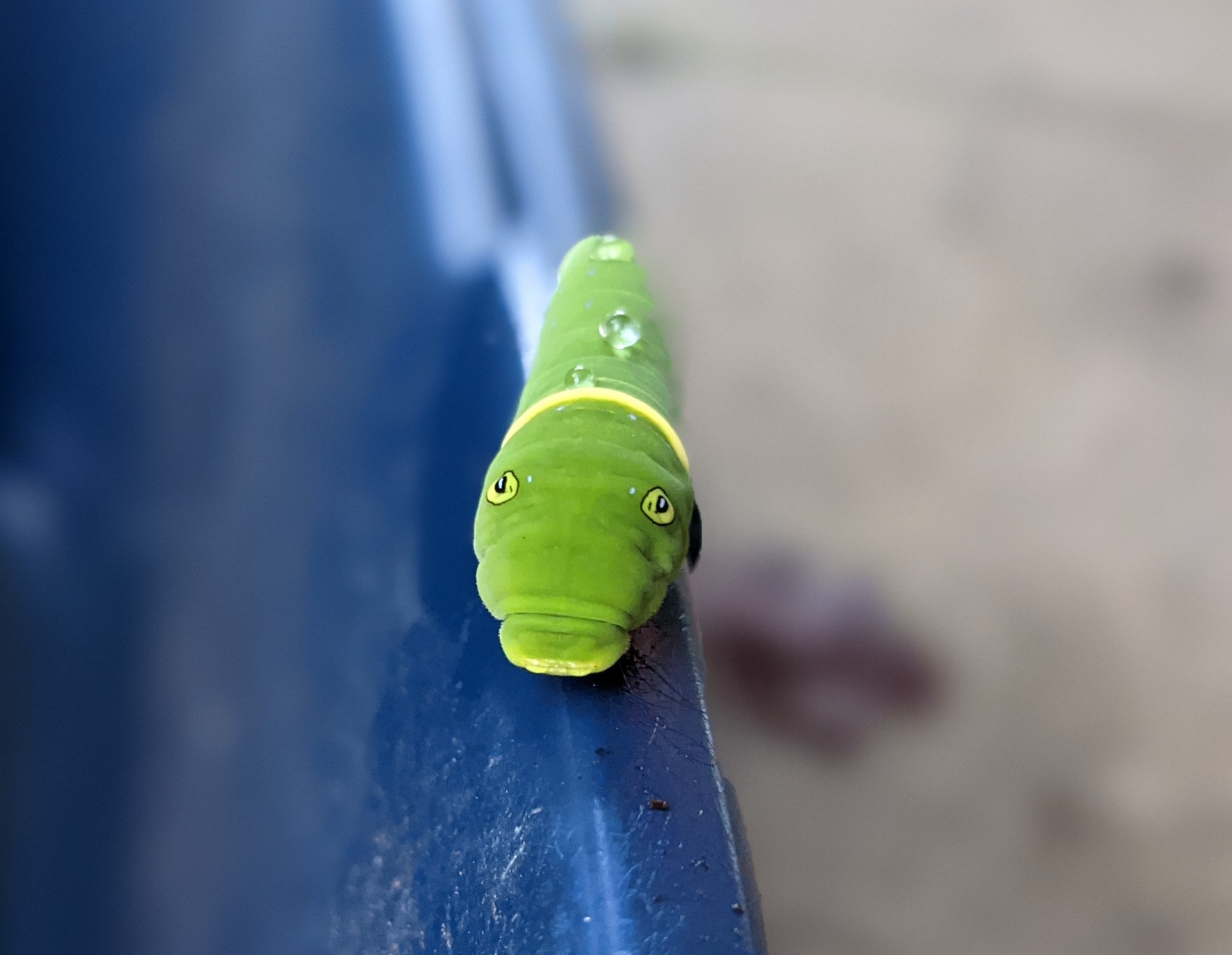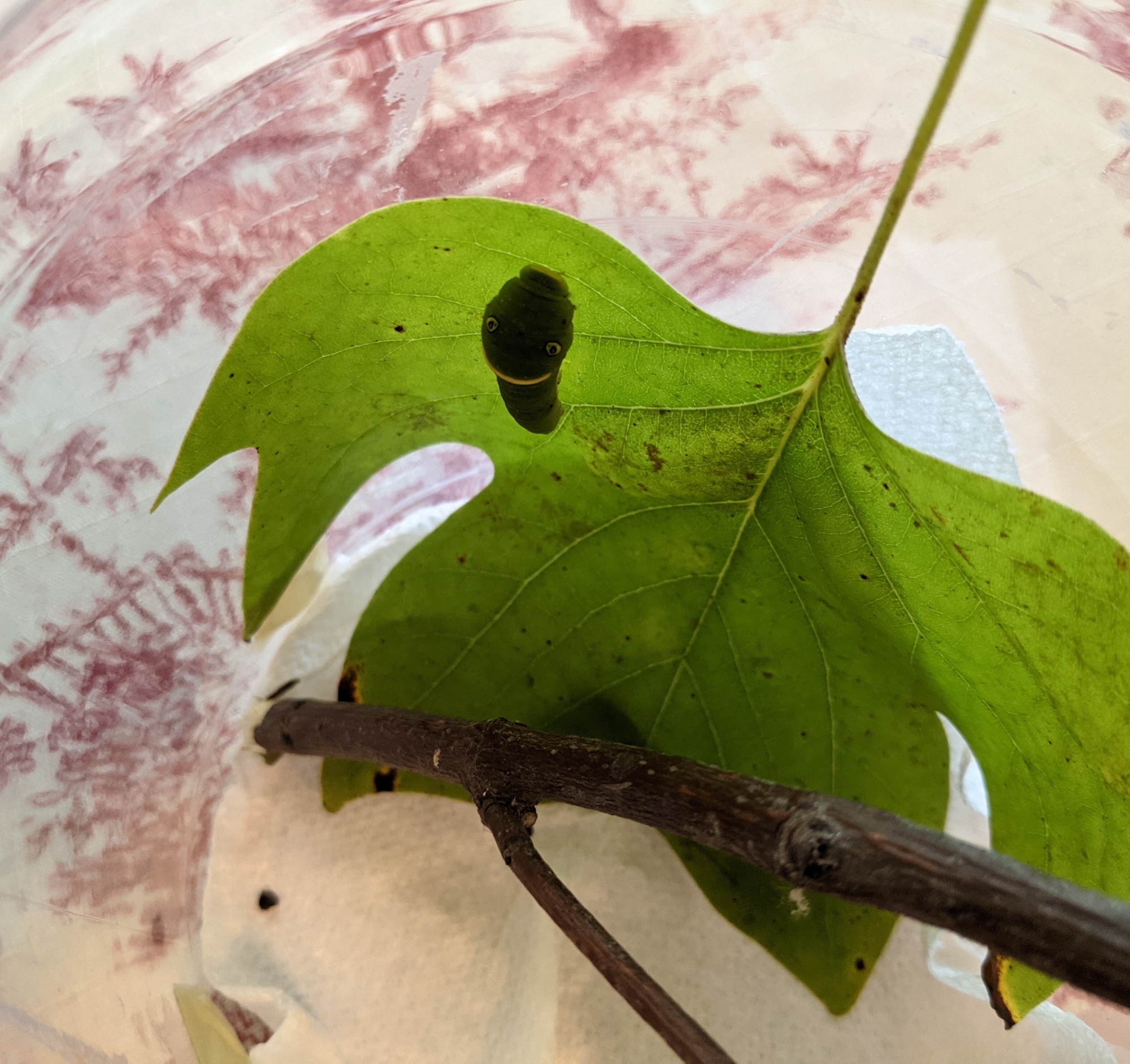
Mornings have been chilly – down in the 60s – and I was very surprised to find a bright green caterpillar on the rim of a tub outside. Having recently researched caterpillars for another post, I knew this was a special caterpillar, and I wondered why it was motionless, out in the open, covered in dew. Was it even alive?
Fortunately, it was definitely alive, but seemed lethargic due to the cold.
I decided to move the caterpillar to a spot where it could warm up in the sun but would blend better with its surroundings – with its bright color, it looked like it belonged in a tree. I placed it in what seemed like a safer spot and continued on with morning chores.

Having time to consider the caterpillar’s situation while I attended to the animals, I struggled with the idea of leaving it where it was: it’s fall already, growing colder, and host plants were becoming hard to find. In addition, butterflies have become so scarce that I wanted to try to help it at least get to the butterfly stage so it could, hopefully, find a mate and either help fertilize or lay eggs.
After some inner debate, I decided to go back to where I had placed the caterpillar and, if it was still there, take it inside. I managed to find it and I placed it in a container with a mesh grid over the top. I went back outside to finish the chores from which I had been distracted.
Returning to the caterpillar’s container, I discovered that it had escaped! It managed to squeeze through the mesh grid and was somewhere in the garage. I could already have stepped on it! I felt my heart sink when I realized that there were many places where the caterpillar could have gone where I might not be able to find it – how terrible to have brought it inside, only to have it die because it was trapped in the garage!
I began searching for the caterpillar, looking under the edges of lids and various feed bags. Nothing. Then, casually, it came walking out from under an empty paper feed bag on the floor. I scooped it up and put it in a container from which it could not escape and breathed a huge sigh of relief.
With the caterpillar safely ensconced in a clean, repurposed coconut oil container (which had already been used as a poultry waterer) I researched its host plants. While it’s possible that we may have chokecherry trees here, the most likely host was tulip poplar. The area that the caterpillar was in was near some young tulip poplars, and there are several on our property. I went out and harvested a couple of large, green leaves and placed them in the caterpillar’s makeshift habitat.
At first, I was worried that the caterpillar didn’t seem to move around much and that it didn’t eat the leaves. I continued to research raising caterpillars and found that they don’t move around much. In addition, they tend to eat at night. In the morning, the caterpillar had eaten a good portion of tulip poplar leaf and there was a large amount of frass (caterpillar poo) on the floor. I had read that a paper towel works well to catch the frass and makes it easy to remove, so I used that method. It also makes the frass easy to see.

It’s been a treat to be able to observe the caterpillar so closely. The Eastern Tiger Swallowtail caterpillar has unique adaptations that allow it to scare off predators that might otherwise try to make a meal of it: it has two large (fake) “eyes” on it that make it look like a much larger creature. It also has the ability to release a foul-smelling substance if it feels threatened.
I think this caterpillar is in its fifth instar, so should form a chrysalis at some point in the near future. I’m new to raising caterpillars, but I’ll be doing my best to keep my small green friend safe, happy, and healthy until s/he becomes a butterfly. At that point, if it’s warm enough, I’ll release him or her into the wild – it’s still getting into the 80s during the day here – and with luck, this amazing creature will help ensure future generations.

Learn more about Eastern Tiger Swallowtail butterflies here.
